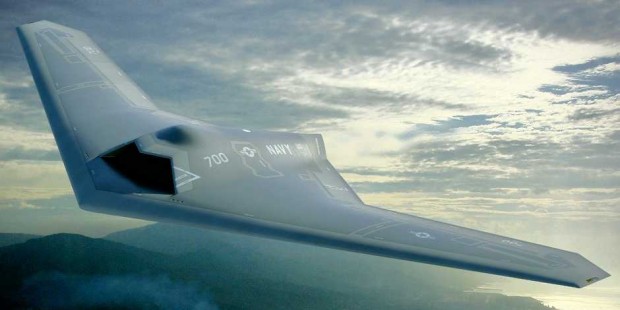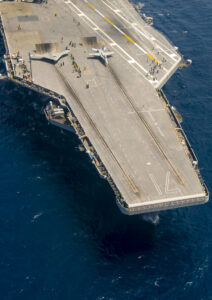
Lockheed Martin’s UCLASS concept.
WASHINGTON: The Navy’s new flying robot fuel truck, CBARS, is being reviewed by senior officials in the Office of the Secretary of Defense, Breaking Defense has learned.
Details about the current review are hard to come by. But our regular readers may be getting déjà vu, because the predecessor program, the UCLASS recon/strike drone, was stuck in OSD review for over a year until it was finally scrapped and replaced by CBARS. Will this new program, announced just weeks ago with the 2017 budget, fall into the same limbo?
The issue last time, with UCLASS, was requirements. Should the Unmanned Carrier-Launched Aerial Surveillance & Strike drone be designed primarily for surveillance — long, slow flights in relatively safe airspace, with a modest capacity for weapons? Or, they asked, should UCLASS be optimized for strike — deep penetration into defended territory with a heavy bombload?
In the end, after bitter debate involving OSD, the Navy, and Capitol Hill, the 2017 budget went with neither. Instead, it replaced UCLASS with the less ambitious and hopefully much more affordable Carrier-Based Aerial Refueling System. CBARS is primarily a tanker, but the Navy says it will have surveillance and “limited strike” capabilities. That makes it sound awfully close to the surveillance-focused version of UCLASS.
When I asked Pentagon officials to clarify what CBARS was supposed to do, I received polite demurrals. No one can comment, they said, until the OSD is finished — which is how I learned of the review. All this suggests, though it hardly proves, that someone in the Office of the Secretary of Defense has the same question I had: Is CBARS a UCLASS-light or something entirely different?

The experimental X-47B drone plugs into an aerial refueling tanker for the first time.
Room To Grow?
Getting requirements right is crucial. Two naval aviation experts I talked to agreed that, if the Navy sets up the drone tanker program properly now, it could ultimately evolve into the much-desired strike aircraft. Write the requirements with too narrow a focus on the immediate mission of aerial refueling, however, and you’ll get design trade-offs that cripple CBARS’s potential to take on other missions.
“I hope that any unmanned tanker design will have the ability to evolve into a deep strike asset,” said Jerry Hendrix, a retired Navy captain now with the Center for a New American Security. “If we don’t close out the potential that it could evolve, then I’m satisfied.”
Evolution into a bomber is possible, he told me, if CBARS is built as a “mission tanker” that refuels strike aircraft en route to the target, rather than as a “recovery tanker” that circles the aircraft carrier waiting to top up planes after they take off or before they land. “We’ve had a recovery tanker for the last 20 years,” Hendrix said. “We haven’t had a mission tanker.”
“If it’s going to be mission tanking — which means it has to accompany the aircraft into the combat zone,” Hendrix said, “the tanker will be of necessity under threat at range, especially when you start thinking about the S-400” and other advanced missiles used in what are often called “anti-access/area denial” defense. That requires a relatively high-performance aircraft that could then swap out some of its fuel load for bomb load, receive new avionics and stealth coatings, and act as a bomber.
“If we design this thing to be able to do Mach 0.8 and fly at 45,000 feet, then it has the ability to go along with [strike] aircraft” — F/A-18E/F Super Hornets and F-35C Joint Strike Fighters — “in their mission altitude and airspeed profiles,” Hendrix said. Basing CBARS on a low-performance surveillance aircraft — like the low-end ideas for UCLASS — would mean it could never do strike missions.

An unmanned X-47B and a manned F-18 Hornet side by side on the USS Roosevelt.
Making CBARS the basis of a future bomber also requires building it with clean lines — in particular, carrying all its fuel internally rather than in tanks under the wing — so it can be made stealthy without a fundamental redesign. It also requires careful design of the engine and how it radiates heat to evade infrared detection.
Traditional Air Force tankers are pretty big radar targets, based as they have been on commercial airplanes. A portion of the F-18 fleet serves as mission tankers, but they aren’t stealthy either.
All the measures that would allow CBARS to become a bomber, however, would make it less efficient or more expensive as a tanker. That’s why former Navy Undersecretary Bob Martinage, now at the Center for Strategic and Budgetary Assessments, was less optimistic.
“Yes, in theory, a CBARS could be built that could evolve into a penetrating surveillance-strike platform,” Martinage wrote me in an email. “To do so, however, the shape of the tanker (i.e., outer mold line) and propulsion path would need to be more or less the same as the penetrator, [which] would mean sub-optimizing it for the ‘tanker’ mission. As far as I’m aware, however, this is not what the Navy is proposing to do.”
“An air vehicle optimized for the tanking mission — which likely means high-aspect wings; wing-body tail shape; and an exposed, high-efficiency engine — cannot evolve into a stealthy penetrator,” Martinage continued. “You could certainly swap out some fuel storage for internal weapons/sensors, or even strap on some weapons externally, but the aircraft will never be ‘stealthy’ in an operationally meaningful sense.”
Yes, a carrier-based tanker is doubly useful. It frees up Super Hornets from “buddy tanking” duties and extends the range of the whole air wing. But, said Martinage, “CBARS does not address the key capability shortfall…insufficient offensive reach and survivability against modern networked IADS (Integrated Air Defense Systems). What is urgently needed to preserve the operational and strategic relevance of the aircraft carrier is the integration of a long-range, penetrating surveillance-strike aircraft.”
Martinage would prefer a concept he calls “A-X,” a carrier aircraft designed primarily for attack missions like the old A-6 Intruder. Design the drone for the most demanding mission, long-range strike, and you can easily modify it to create a tanker variant, he said. It would also cost less than building CBARS narrowly for tanking and then having to start a separate stealth bomber program. It might event take less time, Martinage told me: “Given the progress that has already been made on A-X relevant designs and enabling technology, a carrier-suitable tanker variant could be tested at sea and fielded before CBARS.”
The relevant prior work that Martinage refers to could, in fact, include a classified program for a long-range, stealthy strike aircraft able to operate off carriers. No one I talked to would admit knowledge of such a thing, but one of Martinage’s CSBA colleagues, Bryan Clark, noted a place to get the money.
“I have no idea if there is another program going on,” Clark told me, “but if you look at the language from the (2016 defense bills), Congress added $300 million in FY2016 to the [UCLASS] program….The Navy only plans to spend $135 million on UCLASS/CBARS in FY2016, which was the original amount [requested] in the FY2016 budget. It isn’t clear how DoD plans to spend the other $300 million from FY2016.”
If the Pentagon still has a path to a stealthy, long-ranged, carrier-based bomber — whether in the black budget or through evolving CBARS — then it can probably satisfy the prominent legislators who see such a capability as crucial to countering China, Russia, and Iran. If a pure tanker is the only project in the works, Capitol Hill will have some pointed questions.
In a ‘world first,’ DARPA project demonstrates AI dogfighting in real jet
“The potential for machine learning in aviation, whether military or civil, is enormous,” said Air Force Col. James Valpiani. “And these fundamental questions of how do we do it, how do we do it safely, how do we train them, are the questions that we are trying to get after.”


























